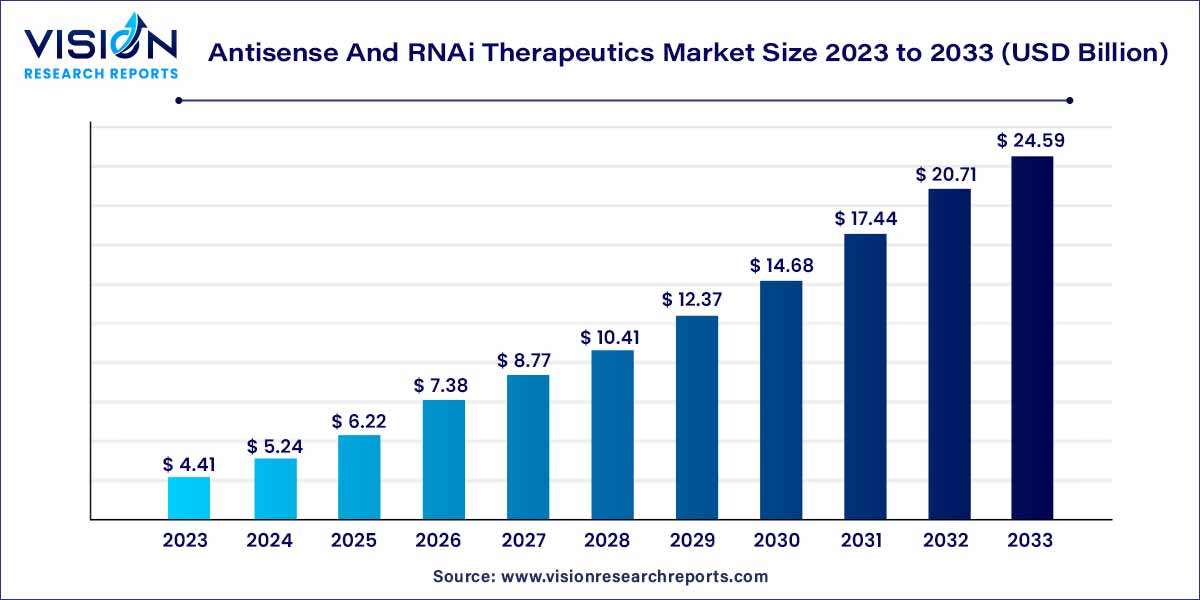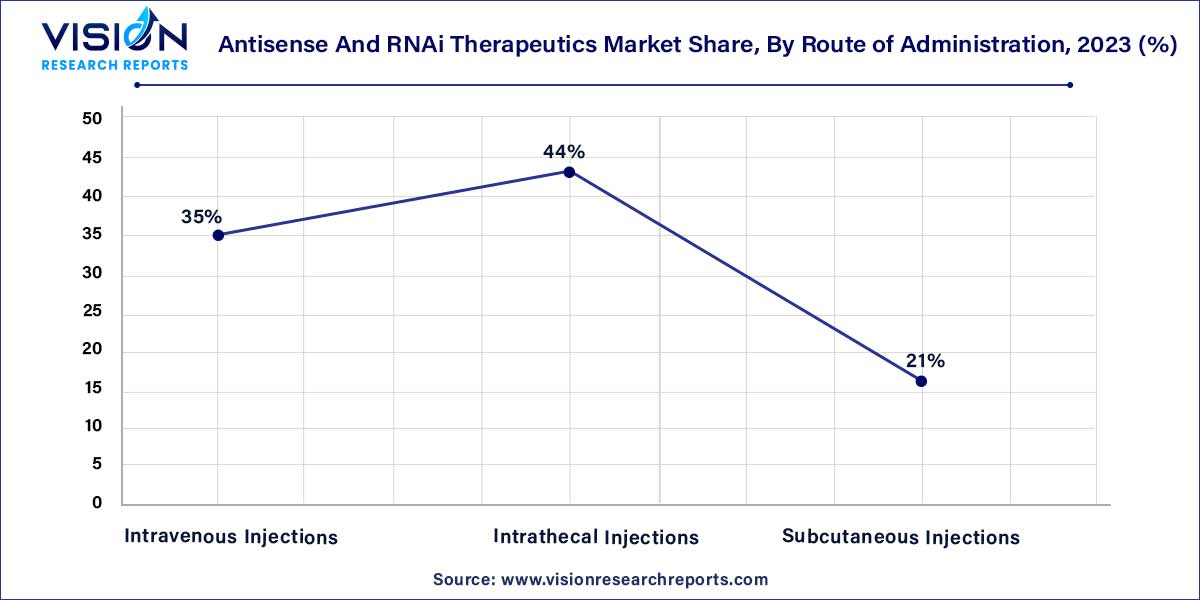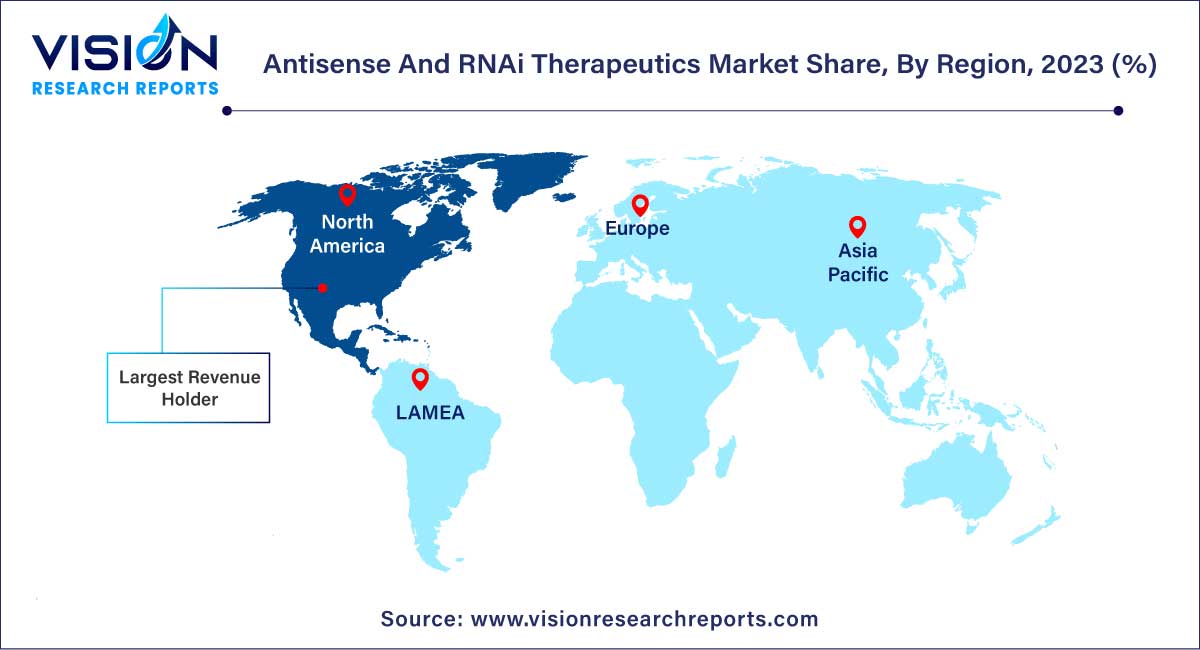The global antisense and RNAi therapeutics market size was estimated at around USD 4.41 billion in 2023 and it is projected to hit around USD 24.59 billion by 2033, growing at a CAGR of 18.75% from 2024 to 2033. The antisense and RNAi therapeutics market is driven by the expanded therapeutic applications, demand for targeted therapies, and technological advancements.

Antisense and RNAi therapeutics function by targeting specific RNA molecules involved in disease processes. Antisense technology involves the use of synthetic nucleic acid sequences to bind complementary RNA sequences, thereby modulating gene expression. RNA interference, on the other hand, utilizes small RNA molecules to silence gene expression by degrading target RNA molecules.
The growth of the antisense and RNAi therapeutics market is fueled by several key factors. Firstly, advancements in nucleic acid technologies have led to the development of more efficient and precise therapeutic agents, driving the expansion of the market. Additionally, increasing research and development activities in the field have uncovered new therapeutic targets and expanded the therapeutic applications of antisense and RNAi technologies. Furthermore, the rising demand for targeted therapies with fewer side effects has spurred the adoption of antisense and RNAi therapeutics across various disease areas, including oncology, infectious diseases, genetic disorders, and neurological disorders. Moreover, strategic collaborations between pharmaceutical companies and research institutions have accelerated the development and commercialization of novel therapeutics, further propelling market growth. Lastly, favorable regulatory frameworks and streamlined approval processes have facilitated the entry of new antisense and RNAi therapeutics into the market, driving innovation and investment in the sector. Overall, these growth factors collectively contribute to the expansion and advancement of the antisense and RNAi therapeutics market.
In 2023, the antisense RNA segment held the largest market share, primarily due to its dominance in revenue generation. Antisense RNA molecules are extensively studied for their potential in controlling various conditions by regulating protein and gene expression. The broad applicability of this technology across cardiovascular, respiratory, neurodegenerative, and genetic disorders is expected to drive segment growth. Numerous studies are underway to evaluate antisense therapeutics for a wide range of disorders. For example, a study published by MDPI in August 2023 concluded that antisense oligonucleotide (ASO) therapies show significant promise in treating various disorders, including infectious diseases. Positive findings from such studies are anticipated to bolster demand for antisense RNA technology in the coming years.
Conversely, the RNA interference technology segment is projected to witness a higher compound annual growth rate (CAGR) of 19.56% over the forecast period. This technique is utilized to investigate gene functions in model organisms and cell cultures and target specific gene sequences implicated in cancer. Additionally, RNAi technology finds extensive applications in treating bacterial diseases, viruses, parasites, and alleviating pain.
In 2023, the neurodegenerative disorders segment commanded the largest market revenue share, accounting for 68%. Industry participants are actively pursuing advancements in RNAi and antisense therapies to address neurodegenerative diseases. For instance, in June 2023, Arrowhead Pharmaceuticals announced its intention to seek regulatory approval in Australia to commence a study on an investigational RNA interference-based therapy for amyotrophic lateral sclerosis (ALS), a neurological disorder. Such initiatives from major companies targeting neurodegenerative conditions are anticipated to fuel segment growth.
On the other hand, the genetic disorders segment is forecasted to exhibit the highest compound annual growth rate (CAGR) of 19.66% over the forecast period. The field of oligonucleotide medicines is rapidly expanding, evident from the increasing number of research studies. Companies are adopting diverse approaches to develop antisense and RNAi therapeutics for genetic diseases. For example, in June 2023, Charles River Laboratories International, Inc. collaborated with the Korean biotechnology company, Curigin, to produce oncolytic RNA interference (RNAi) gene therapy
In 2023, the intrathecal injections segment emerged as the market leader, capturing a share of 44%. This method involves administering drugs via injection into the subarachnoid space or spinal canal to reach the cerebrospinal fluid. Intrathecal injections are commonly used in spinal anesthesia, chemotherapy, pain management, and delivering drugs to combat specific infections, particularly post-neurosurgical procedures. The route of drug administration plays a critical role in the effectiveness of every genetically modified molecule.

Conversely, the subcutaneous injection segment is poised to witness the highest compound annual growth rate (CAGR) of 19.98% over the forecast period. Subcutaneous injections are administered into the fatty tissue just beneath the skin. This method offers flexibility in selecting the infusion site, including options such as the abdomen, thighs, and back of the arms. Moreover, subcutaneous infusion systems can utilize smaller needle sizes, potentially reducing discomfort during the infusion process. These advantages associated with subcutaneous administration are expected to drive segment growth in the foreseeable future.
In 2023, North America emerged as the dominant force in the global market, capturing a significant share of 65%. Moreover, the region is projected to experience the fastest compound annual growth rate (CAGR) during the forecast period. The United States, in particular, is witnessing the development of various RNAi therapies, with substantial investments from players in the biotechnology sector. Major pharmaceutical and biotechnology companies in North America are actively engaged in innovating RNAi therapeutics. For instance, in May 2023, Codexis, Inc., a U.S.-based organization, unveiled its Enzyme-Catalyzed Oligonucleotide (ECO) Synthesis technology platform for large-scale manufacturing of RNA oligonucleotide therapeutics. This innovative technology was introduced at the TIDES U.S. annual meeting, signaling significant advancements in the field. Such technological breakthroughs across the United States are poised to propel the North American market forward in the coming years.

Meanwhile, the Europe antisense and RNAi therapeutics market is forecasted to witness substantial growth. The region boasts the presence of various companies dedicated to antisense and RNAi therapeutics, driving regional expansion over the forecast period. These companies are actively pursuing initiatives to broaden their product portfolios and explore new business avenues. For instance, in March 2023, SciNeuro Pharmaceuticals, a U.S.-based organization, partnered with Europe-based Secarna Pharmaceuticals GmbH & Co. KG to develop novel antisense oligonucleotide (ASO) therapies targeting critical disease pathways in the Central Nervous System. This collaboration exemplifies the increasing focus of players from other regions on tapping into the European market potential, further fueling regional growth prospects in the foreseeable future.
By Technology
By Application
By Route of Administration
By Region
 Cross-segment Market Size and Analysis for
Mentioned Segments
Cross-segment Market Size and Analysis for
Mentioned Segments
 Additional Company Profiles (Upto 5 With No Cost)
Additional Company Profiles (Upto 5 With No Cost)
 Additional Countries (Apart From Mentioned Countries)
Additional Countries (Apart From Mentioned Countries)
 Country/Region-specific Report
Country/Region-specific Report
 Go To Market Strategy
Go To Market Strategy
 Region Specific Market Dynamics
Region Specific Market Dynamics Region Level Market Share
Region Level Market Share Import Export Analysis
Import Export Analysis Production Analysis
Production Analysis Others
Others